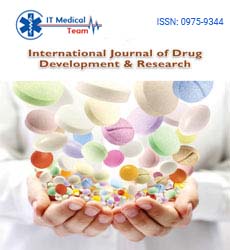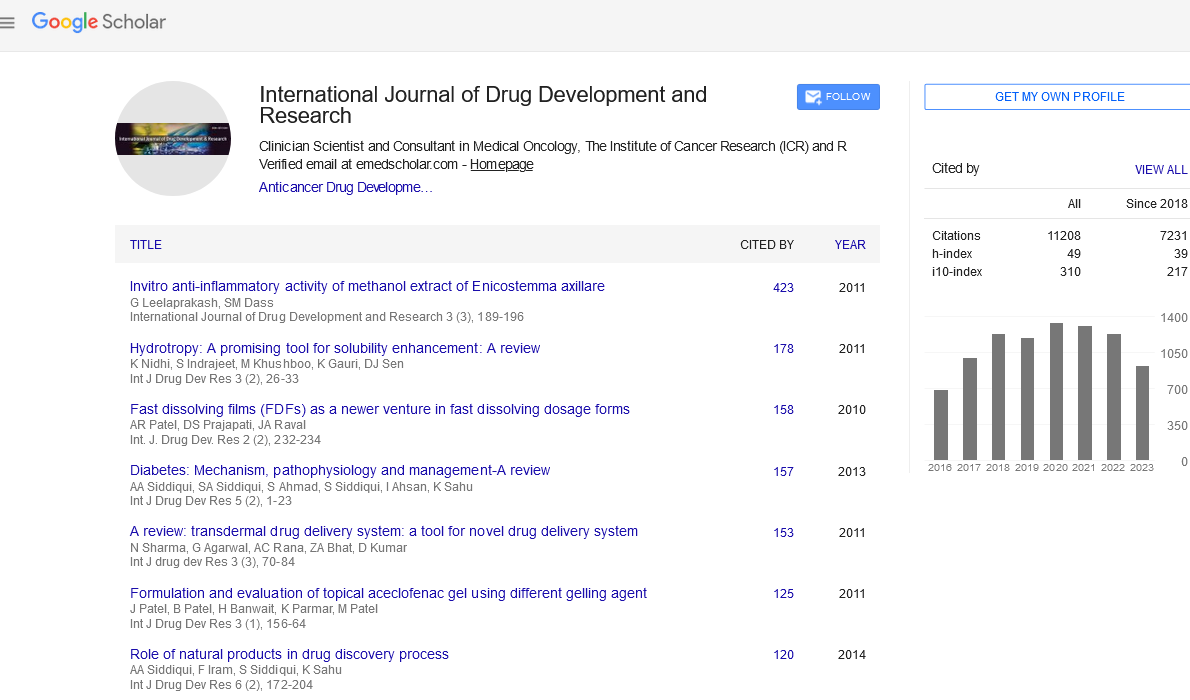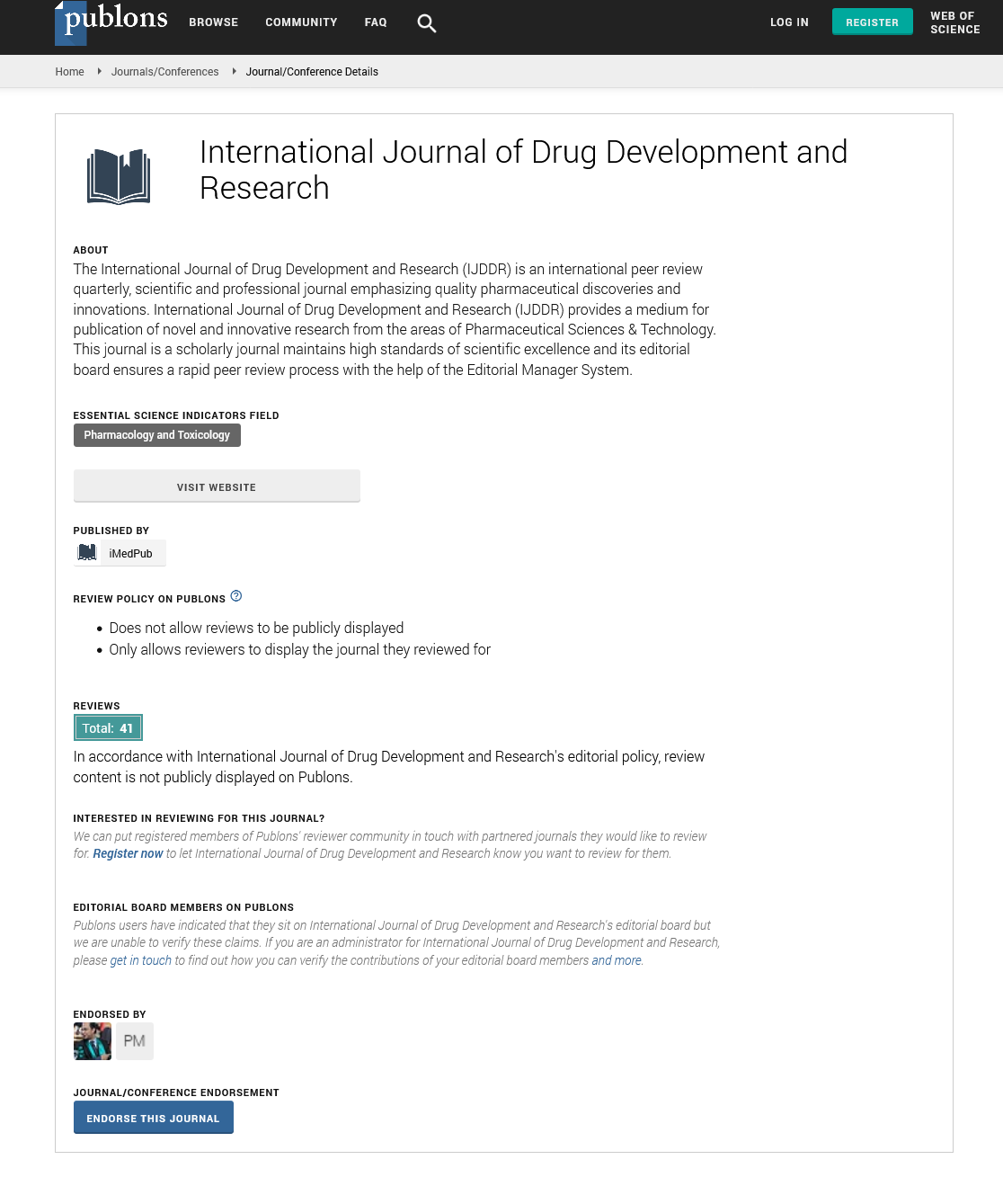Key words
|
| Quetiapine fumerate, method development, validation, UV spectrophotometry, tablet dosage form. |
INTRODUCTION
|
| Quetiapine fumerate[1] is an atypical antipsychotic approved for the treatment of schizophrenia, acute episodes of bipolar disorder (manic, mixed or depressive), and a n augmenter for the maintenance treatment of depression and bipolar disorder. Quetiapine[1,2] is a dopamine, serotonin, and adrenergic antagonist, and a potent antihistamine with clinically negligible anticholinergic properties. Quetiapine received its initial indication from the U.S. Food and Drug Administration for treatment of schizophrenia in 1997. In 2004, it received its second indication for the treatment of mania-associated bipolar disorder. In 2007 and 2008, studies were conducted on quetiapine’s efficacy in treating generalized anxiety disorder and major depression. Quetiapine fumerate[3,4] (QTF) is 2- (2- (4-dibenzo[b,f] [1,4] thiazepine- 11-yl- 1-piperazinyl) ethoxy) ethanol. QTF Appears as white crystalline solid and Stored at room temperature. It is soluble in methanol, ethanol, Chloroform, 0.1 M HCl, phosphate buffer, sparingly soluble in water. Its structure is given below. |
 |
| Qutiapine[6] binds strongly to serotonin receptors. Serial PET scans evaluating the D2 receptor occupancy of quetiapine have demonstrated that quetiapine very rapidly disassociates from the D2 receptor. Theoretically, this allows for normal physiological surges of dopamine to elicit normal effects in areas such as the nigrostriatal and tubero-infundibular pathways, thus minimizing the risk of side-effects such as pseudo-parkinsonism as well as elevations in prolactin. Some of the antagonized receptors (serotonin, norepinephrine) are actually auto receptors whose blockade tends to increase the release of neurotransmitters. |
| Several methods have been reported for the quantitative determination of quetiapine in bulk, and pharmaceutical and biological samples. These methods include UV-Visible spectrophotometric[10-15], HPLC methods[16-19] , HPTLC[20] , UPLC[21], complexometric method[22] and Hyphenated techniques such as LC-MS[23], HPLC-MS-MS method[24] and HPLC electro-spray mass spectrophotometry[25]. |
| The aim of present study was to develop and validate [7,8,9] an accurate, specific and reproducible UV method for determination of quetiapine fumarate as in marketed tablet dosage formulation . |
MATERIALS AND METHODS
|
Chemicals and Reagents
|
| Pure sample of Quetiapine fumarate (QTF) was generous gift from Wockhardt Pharmaceuticals Ltd., Aurangabad. Tablets of same strength and different brands were procured from local pharmacy, Water, Methanol, Mortar pestle, Whattman filter paper no.1, all other reagents used were of analytical grade. |
Instrumentation
|
| A double beam UV spectrophotometer TECHCOMP was used for the detection of absorbance, Denwer Semi micro as analytical weighing balance and PCI analytics sonicator of 1.5 litres, borosil glass apparatus were used for experimental purpose. |
UV Spectroscopic Method
|
Preparation of Stock Solutions
|
| Standard solution of QTF was prepared by dissolving 29 mg of Quetiapine fumarate in 25 ml of methanol solution to get concentration of 1000 μg/ml. |
Determination of λ max
|
| From the stock solutions, a working standard was prepared. The absorption spectrum for Quetiapine, was recorded using 20 μg/ml solution and the maximum absorption was found to be 290 nm (Fig.1). |
Preparation of Standard Solutions
|
| Different aliquots of stock solution were transferred into series of 25 ml volumetric flasks and the volume was made up to the mark with methanol : water in the ratio of 50:50v/v to obtain concentrations 15.99- 24.09 μg/mL. Scanning range was finalized for study and solutions were scanned on spectrophotometer in the UV range of 200 - 400 nm and the Calibration curves were prepared for QTF. The plots of Beer’s law limit are shown in Fig. 2. |
Preparation of Sample Solution
|
| Tablet samples A and B , label claimed 25 mg of Quetiapine per dosage unit . The average weight was determined with 20 tablets, which were grounded in a mortar until fine powder. Accurately weighed amount of powder equivalent to 29 mg of Quetiapine fumarate was quantitatively transferred to a 25 ml calibrated flask with the aid of methanol. The volume was made up to mark, sonicate for 10 min and filtered through whatman Filter paper no.1. The filtrate is suitably diluted to get a final conc. of 20 μg /ml Quetiapine fumarate. Then the solution was scanned at 290 nm.The spectra of sample was shown in Fig. 3&4. |
Method Validation
|
| Validation of the analytical method for the determination of Quetiapine fumerate bulk and its tablet dosage form was carried out as per ICH guidelines. |
Linearity Range
|
| Linearity was performed by taking aliquots from stock solution (1mg/ml) in 25ml volumetric flasks and diluted up to the mark with methanol: water in the ratio 50:50v/v such that the final concentration of Quetiapine fumerate in the range of 16 to 24 μg/ml. Under the experimental conditions described the graphs obtained by plotting concentration Vs absorbance .The observations and calibration curve is shown in Table 1 and Fig. 2. |
Accuracy and Recovery
|
| Accuracy is the percent of analyses recovered from the assay from a known added amount. Data from nine determinants from three concentration levels covering the specified range were obtained. To verify the capability of regression equations to predict the absorbance behavior of Quetiapine fumarate in dosage forms, the method was tested for accuracy and recovery. To study the recovery of the preanalyzed sample solutions, a known amount of standard solutions of the pure drugs were added at different level i.e. 110, 120 and 130 %. Recovery study was determined by following formula; |
| % Recovery = [A-B/ C] X 100 |
| Where, A = Total amount of drug estimated |
| B = Amount of drug found on pre-analyzed basis |
| C = Amount of drug added |
| The result of recovery studies are presented in Table 3. |
| The mean recovery of the two brands (A & B) were found to be 100.41% and 99.77% respectively, indicates very good reproducibility of these methods. |
Precision
|
| Precision is the degree of repeatability of an analytical method under optimal conditions. The precision were determined with standard quality control samples (in addition to linearity standards) prepared in triplicate at different concentration levels covering the entire linearity range. The precision of the method was determined by repeatability and reported as % RSD for a statistically significant number of replicate measurements. |
RESULTS AND DISCUSSION
|
| The developed method of spectrophotometric determination of QTF in tablet formulation was found to be absolute and persuading for the routine analysis of drug. In our study, QTF was analyzed using UV Spectrophotometric method where the UV Spectra of QTF were recorded over the range 200 – 400 nm in Methanol : water in the ratio of 50: 50v/v at 290 nm. |
| Linearity studies were carried out in the concentration range of 16 - 24 μg/mL and the sample solution is obtained from the stock solution. The readings are obtained by measuring the absorbance at 290 nm presented in Table 1 and curve was shown in Fig.2. |
| The proposed method can be successfully applied for the assay of QTF in tablet dosage forms without any interference. The assay showed the drug content of this product to be in concordance with the labeled claim 25 mg. the values are given in the Table 2. |
| The utility of this method was determined by means of the recovery assay in marketed tablet samples (Brand A & Brand B of same strength). Recoveries were determined by standard addition method (SAM). The mean percentage recoveries of QTF of Brand A & B by UV method were found to be 100.41% & 99.77% respectively. The results of the recovery studies were given in Table 3. |
| Performing replicate analyses of standard solution was used to assess the precision, repeatability and reproducibility of the proposed method. The selected concentration within the linearity range was prepared by using methanol : water in the ratio of 50:50 and analyzed with the relevant calibration curves to determine the variability. The precision was determined as the % RSD. The results of the precision are given in the Table 4, which demonstrate a good precision. |
CONCLUSION
|
| The developed UV spectrophotometric method are accurate, simple, rapid, precise, reliable, sensitive, reproducible and economical for the determination of QTF and its pharmaceutical tablet dosage forms. The reagents utilized in the proposed methods are cheap, readily available and the procedure does not involve any critical reaction conditions or tedious sample preparation. The methods are more selective than many of the reported spectrophotometric methods and employs higher wavelength to measure absorbance readings where the errors due to inactive ingredients are minimized to a large extent. The methods are free from interferences from the common excipients. The statistical parameters and the recovery data reveal good accuracy and precision of the methods. These methods can be used as general methods for the determination of QTF in bulk powder and dosage forms. The methods have many advantages over the separation techniques such as HPLC and include reduced cost, and speed with high accuracy. Hence, the methods can be used in routine analysis of drug in quality control laboratories. |
ACKNOWLEDGEMENT
|
| The authors are thankful to Wockhardt Pharmaceuticals Ltd., Aurangabad, India, for providing pure QTF sample. The authors also express their gratitude to the Management, Periyar College of Pharmaceutical Sciences, Trichy for providing their continuous support throughout the work. |
| |
Tables at a glance
|
 |
 |
 |
 |
| Table 1 |
Table 2 |
Table 3 |
Table 4 |
|
| |
Figures at a glance
|
 |
 |
 |
 |
| Figure 1 |
Figure 2 |
Figure 3 |
Figure 4 |
|
| |
References
|
- 1) https://en.wikipedia.org/wiki/Quetiapine.
- 2) https://www.ncbi.nlm.nih.gov/pubmedhealth/PMH 0001030.
- 3) https://www.nlm.nih.gov/medlineplus/druginfo/me ds/a698019.html
- 4) https://www.medicinenet.com/quetiapine/article.ht ml
- 5) Guidance for Industry: Analytical Procedures and Methods Validation: Chemistry, Manufacturing and Controls Documentation; Draft Guidance. Rockville, MD. US FDA. 2000.
- 6) International Conference on Harmonization (ICH), Q2 (R1), “Validation of Analytical Procedures: Text and methodology” . 2000.
- 7) International Conference on Harmonization. "Q2A: Text on Validation of Analytical Procedures," Federal Register. 1995; Vol. 60(40): 11260 - 11262.
- 8) International Conference on Harmonization. "Q2B: Validation of Analytical Procedures: Methodology; Availability," Federal Register. 1997; Vol. 62(96): 27463 - 27467.
- 9) Validation reqirements of the U.S Food and Drug administraton. The U.S Pharmacopoiea and International Conference on Hanmonization.J Cromatogr A. 2003; Vol. 987: 57- 66.
- 10) Srihari G, and Chakravarthi IE.Simple Spectrophotometric method for determination of Quetiapinefumarate in tablets. Int. J. Chem. Sci. 2011; Vol. 9(2): 949 - 952.
- 11) Sudarshan Reddy P, Ashok Reddy S, Karthikvarma K, NarasimhaRao D, PanjagalaSatyanarayana, NagaRaju TM. Method development and validation of Quetiapinefumerate bulk and in tablet dosage form by using UV-Spectrophotometry. Int. J. Pharm & Ind. Res. 2011; Vol. 1 (3): 195 - 199.
- 12) KanakapuraBasavaiahVinay, HosakereOddarevannaRevanasiddappa, PavagadaJagannathamurthy Ramesh, and NagarajuRajendraprasad. Titrimetric and Sensitive Spectrophotometric Methods for the Assay of Quetiapinefumarate in Pharmaceutical Formulations.Chemical Industry & Chemical Engineering Quarterly. 2011; Vol. 17 (1): 99 - 106.
- 13) Prasanth VG, SusammaCicyEapen, SheejaVelayudhanKutty, and Jyothi TS.Development and validation of Quetiapinefumarate in pure and pharmaceutical formulation by UVSpectrophotometric method.Der Pharmacia Sinica. 2011; Vol. 2 (6) : 52 - 58.
- 14) BorkarBhaskarHiraman, VidhateSandip, Lohiya RT, Umekar MJ. Spectrophotometric Determination Of An Atypical Antipsychotic Compound In Pharmaceutical Formulation. Int.J. Chemtech Res. 2009;Vol 1(4): 1153 – 1161.
- 15) Bagade SB, Narkhede S, Nikam DS, Sachde CK. Development and validation of UVSpectrophotometric method for determination ofQuetiapinefumarate in two different dose tablets. Int.J. ChemTech Res.2009; Vol 1(4): 898 - 904.
- 16) BasaveswaraRao MV, Nagendrakumar AVD. Validated RP - HPLC method for the estimation of Quetiapine in formulation.International Journal of Science Innovations and Discoveries. 2011; Vol 1 (1), 45-52.
- 17) Sravankumar G, VidyadhariCh, Vijay Kumar B, Shameemsulthana, Sravankumar V, Aneela, Somnath De S. Development and Validation of RPHPLC method for determination of Quetiapinefumarate from pharmaceutical preparation. International Journal of Biological & Pharmaceutical Research. 2011; Vol 2(1): 27-33.
- 18) Sudarshan Reddy P, PanjagalaSatyanarayana, KarthikVarma K, Naga Raju, Siva Kumar G, Shanmugasundaram P. Novel Reverse Phase HPLC method development and validation of Quetiapinefumerate in bulk and tablet dosage form. Int. J. Pharm & Ind. Res. 2011; Vol 1 (2): 95 - 99.
- 19) VenkataKiran B, BattulaSreenivasaRao, and Som Shankar Dubey. Validation of QuetiapineFumarate in Pharmaceutical Dosage by Reverse Phase HPLC with Internal Standard Method.Vol 3: 1 – 20.
- 20) MudigondaSrinivas, Suresh kumar R, Krishna murthy M, ShakilSai, and Mukkanti K. A novel, sensitive and rapid method developed for simultaneous quantification of four potential genotoxic impurities in Quetiapinefumarate by UPLC. Journal of Pharmacy Research. 2012; Vol. 5(4): 2042-2044.
- 21) RamuSathiya, KaliaperumalKrishnaraj, SelvaduraiMuralidharan, and NithyananthamMuruganantham.A Simple and Validated HPTLC Method of Evaluation for Quetiapinefumarate in Oral Solid Dosage Form. Eurasian J Anal Chem. 2011; Vol. 5(3): 246-253.
- 22) Vinay KB, Revenasiddappa HD. Spectrophotometric Determination OfQuetiapineFumarate through Ion-pair Complexation Reaction with Tropaeolinooo. Indian Journal Chemical Technology. 2012; Vol. 19 (2): 205−212.
- 23) ShaheMahammadS ,MadhusudhanaChetty, Ramana Murthy KV. Validated LC-UV method for the estimation of Quetiapine in pharmaceutical dosage forms.Journal of Global Trends in Pharmaceutical Sciences. April-June 2012; Vol. 3 (2): 671-676.
- 24) Barrett B, Hol?capek M, Huclov´a, Bo?rek- Dohalsk´y V, Fejt P, N?emec. B, Jel´?nek I. Validated HPLC–MS/MS method for determination of quetiapine in human plasma.Journal of Pharmaceutical and Biomedical Analysis. 2007; Vol. 44 : 498–505.
- 25) Shen-Nan tin, Yan Chang, David E. Moody and Rodger t. Foltz. A Liquid Chromatographic- Electrospray-Tandem Mass Spectrometric Method for Quantitation of Quetiapine in Human Plasma and Liver Microsomes. Application to a Study of In Vitro Metabolism.Journal of Analytical Toxicology.September 2004; Vol. 28: 443 - 448.











